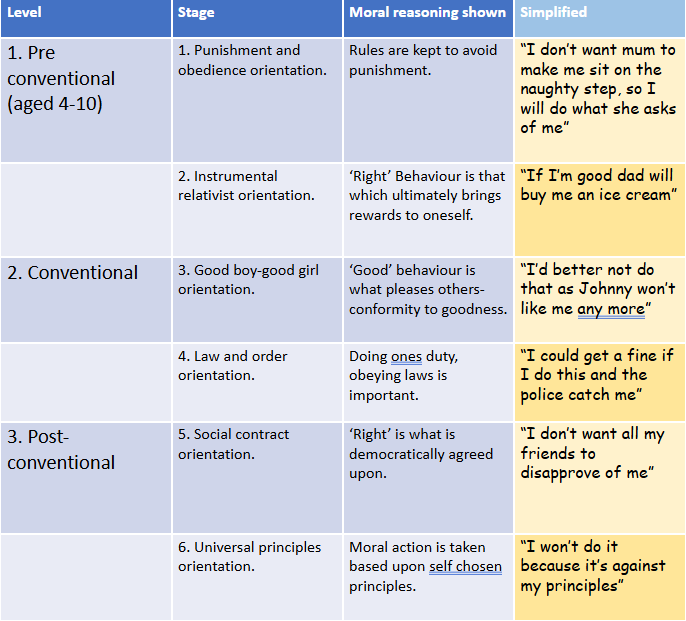Kohlberg
1/12
There's no tags or description
Looks like no tags are added yet.
Name | Mastery | Learn | Test | Matching | Spaced |
|---|
No study sessions yet.
13 Terms
What is the aim of Kohlberg’s study?
To show how as young adolescents develop into young manhood, they move through distinct stages of moral development
What is the background for Kohlberg’s study?
Kohlberg expanded on Piaget’s notions of moral development as he saw it as more of a gradual process
Piaget underestimated the age that children considered other people’s moral intention and start to see that rules are created by people and can be negotiated
He believed this ability came at age 10 or older
What was Kohlberg’s theory of moral development?
He believed that it was a more gradual process
He divided stages of moral development into a 3-level, 2-stage sequence of development
Moral development proceeds from selfish desire to avoid punishment or be rewarded, to concerning itself with societal functioning, then to a consistent application of universal ethical principles

What is the sample for this study?
75 American boys
Ages 10-16 at the start of the study till ages 22-28 at the end of the study (Assessed for 12 years)
Cross-cultural study- studied boys in other cultures including Great Britain, Canada, Taiwan, Mexico and Turkey
How often were the main sample assessed?
At 3 year intervals 4 times
What is the research method for this study?
Longitudinal study- happened across 12 years
Semi-structured interviews
What is the procedure for the main study?
Participants were presented with hypothetical moral dilemmas in the form of short stories to solve
45 minutes long with 9 dilemmas
The dilemmas were related to 25 moral concept Kohlberg identified such as ‘the value of life’ and used to determine a stage of a participants moral reasoning
Examples of ‘the value of life’ being tested were
Age 10- Is it better to save the life of one important person or a lot of unimportant people
Aged 13, 16, 20, and 24- “Should the doctor ‘mercy kill’ a fatally ill woman requesting death because of her pain’
The answers were recorded in a scoring manual- this turned qualitative data into quantitative data, but the main data gathered is still qualitative
How were other cultures assessed?
Taiwanese boys aged 10-13 were asked about a story involving the theft of food:
“A man’s wife is starving to death but the store owner won’t given the man any food unless he can pay, which he can’t. Should he break in and steal some food? Why?”
Young boys in Great Britain, Canada , Mexico and Turkey were tested in a similar way
What are the results from the main study?
Not all participants reached stage 6 or moral development
Participants always progressed through stages of moral development sequentially and in the same order
A child at an earlier stage tends to move forward when confronted with the views of a child in the next stage, and they seem to prefer this next stage- social learning theory
Middle-class children more morally advanced than matched lower-class children, perhaps due to levels of education
A child once progressing onto the next stage never moved back
What results were found from other cultures?
Taiwanese boys aged 10-13 gave a classic stage-2 response
Mexico and Taiwan showed the same results except that development was a little slower
At the age of 16, stage-5 thinking was much more prevalent in the US than either Mexico and Taiwan
What conclusions can be drawn from this study?
Findings support Kohlberg’s six-stage theory
Individuals move sequentially through stages of moral development but may never reach the final stage
The order of stages is universal across all cultures (nature)
How does Kohlberg’s study relate to the developmental area?
The developmental area suggests that thinking changes systematically through crucial stages of moral development
Kohlberg aimed to investigate how moral reasoning developed in young males as they age.
75 American boys were studied in a longitudinal study for 12 years and given semi-structured interviews at 3 year intervals until 22-28
A cross-cultural design was used to study other cultures like Taiwan, Mexico and GB and all participants were given 9 moral dilemmas and interviewed as to what the character in their story should do
All participants went through stages of moral development sequentially and never moved back a stage
This links to the principle as it shows moral development occurs at fixed stages in all people showing how people go through crucial stages of development
How does Kohlberg’s study relate to they key theme of moral development?
Moral development refers to the way inwhich individuals make decisions about what is right and wrong as they mature
Kohlberg aimed to investigate how moral reasoning developed in young males as they age.
75 American boys were studied in a longitudinal study for 12 years and given semi-structured interviews at 3 year intervals until 22-28
A cross-cultural design was used to study other cultures like Taiwan, Mexico and GB and all participants were given 9 moral dilemmas and interviewed as to what the character in their story should do
All participants went through stages of moral development sequentially and never moved back a stage
This suggests moral development is affected by nature due to changes with age and by nurture, due to differences in cultures